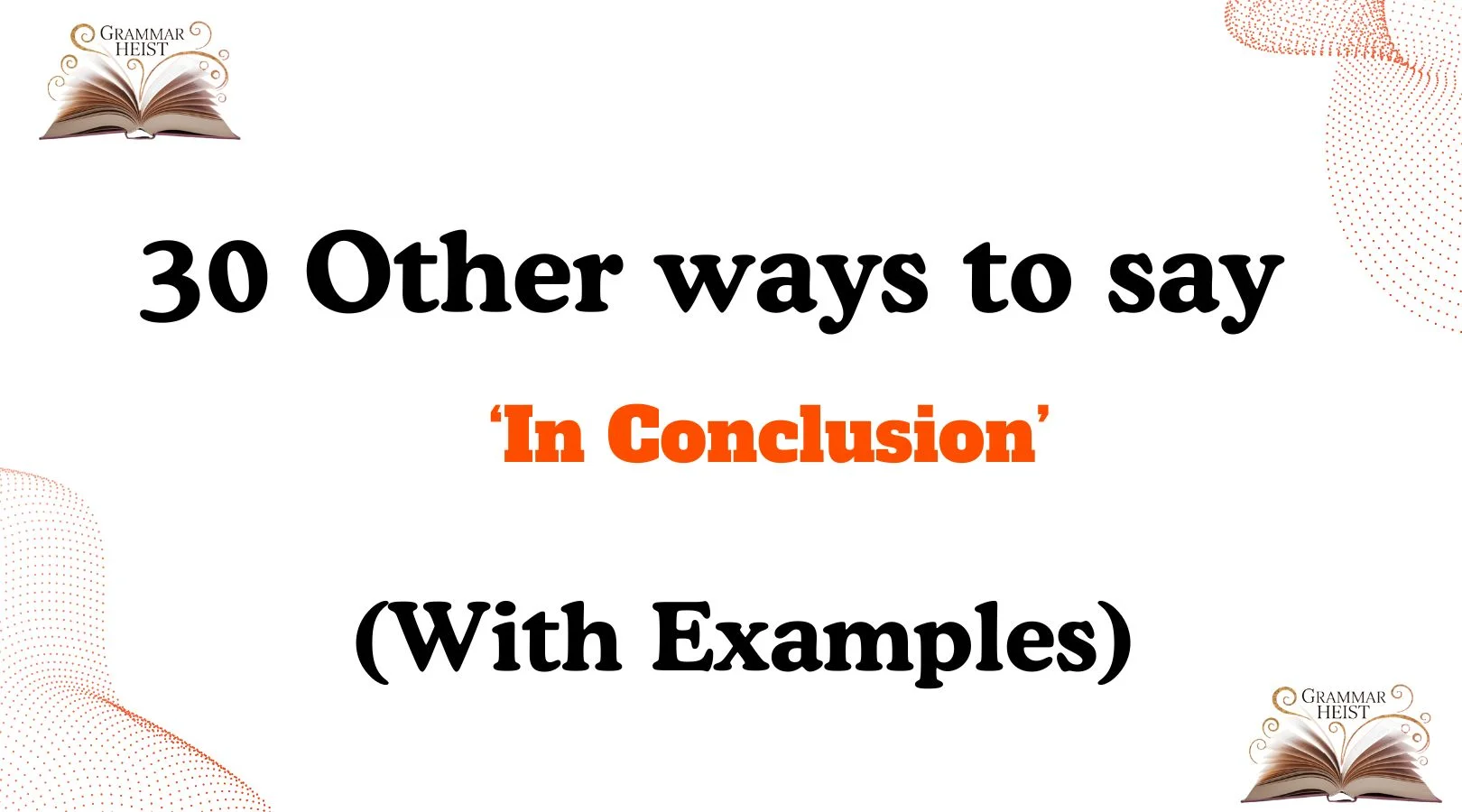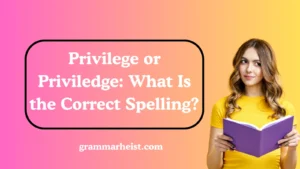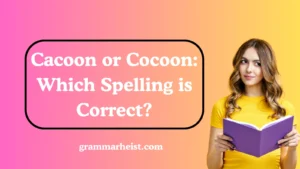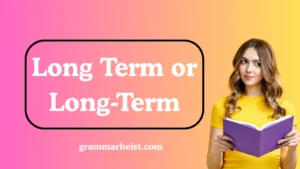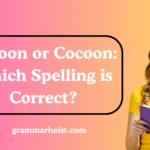Finding the right words to end your message can make your communication feel warm, thoughtful, and genuine. Using alternatives to “in conclusion” allows your writing to sound more natural, personal, and engaging—whether you’re closing an email, wrapping up an essay, or finishing a heartfelt note. These 30 other ways to say “in conclusion” give your words a gentle touch that connects with your reader on a more meaningful level.
What Does “In Conclusion” Mean?
The phrase “in conclusion” is commonly used to signal the end of a thought, summarize main points, or wrap up an argument. It tells the reader or listener that the discussion is coming to a close and that what follows is the final thought or key takeaway.
Is It Professional or Polite to Say “In Conclusion”?
Yes, using “in conclusion” is polite and professional, especially in formal writing like reports, presentations, essays, or speeches. However, using it too often can sound repetitive or stiff. That’s why having a list of natural alternatives can make your communication more engaging and human.
Pros and Cons of Using “In Conclusion”
Pros:
- ✅ Clear and easy to understand
- ✅ Works well in formal writing
- ✅ Signals a strong wrap-up
Cons:
- ❌ Can sound too formal or robotic in casual settings
- ❌ Overused in academic writing
- ❌ Lacks emotional warmth or personality
Synonyms For “In Conclusion”
- To sum up
- All things considered
- In summary
- To wrap it all up
- To conclude
- At the end of the day
- Ultimately
- In closing
- As a final point
- All in all
- On the whole
- To finish off
- To bring it all together
- Wrapping up
- To conclude my thoughts
- To round things off
- In a nutshell
- To end on a high note
- When all is said and done
- Finally
- To sum everything
- To wrap things up
- In essence
- In short
- To bring it to a close
- To end with
- As we conclude
- To summarize everything
- To draw things to a close
- To conclude this message
1. To Sum Up
Scenario: Perfect for summarizing points in a friendly yet professional tone.
Examples:
- “To sum up, this project was a success because of everyone’s hard work.”
- “To sum up, communication was key to making this possible.”
- “To sum up, we achieved more together than we ever could alone.”
Tone: Warm, clear, and inclusive.
Explanation: A gentle and simple way to wrap up without sounding stiff.
2. All Things Considered
Scenario: Ideal for reflective and thoughtful conclusions.
Examples:
- “All things considered, this was a meaningful experience.”
- “All things considered, the benefits outweigh the challenges.”
- “All things considered, it was the right decision.”
Tone: Reflective and balanced.
Explanation: Shows careful thought before closing.
3. In Summary
Scenario: Best for short and professional messages or essays.
Examples:
- “In summary, we reached our goals successfully.”
- “In summary, the results exceeded expectations.”
- “In summary, teamwork made the difference.”
Tone: Concise and clear.
Explanation: Gives a polished and professional closing.
4. To Wrap It All Up
Scenario: Great for casual, warm, or creative communication.
Examples:
- “To wrap it all up, this journey has been incredible.”
- “To wrap it all up, I’m truly proud of everyone.”
- “To wrap it all up, it was worth every moment.”
Tone: Friendly and light.
Explanation: Adds personality to the closing.
5. To Conclude
Scenario: Excellent for formal presentations or reports.
Examples:
- “To conclude, our findings support the hypothesis.”
- “To conclude, we recommend this approach moving forward.”
- “To conclude, collaboration is key.”
Tone: Professional and strong.
Explanation: Direct and authoritative way to finish.
6. At the End of the Day
Scenario: Casual and personal reflections.
Examples:
- “At the end of the day, what matters most is kindness.”
- “At the end of the day, we grew together.”
- “At the end of the day, the effort was worth it.”
Tone: Warm and conversational.
Explanation: Ideal for heartfelt messages or speeches.
7. Ultimately
Scenario: Good for clear, final statements.
Examples:
- “Ultimately, the choice is yours.”
- “Ultimately, we succeeded together.”
- “Ultimately, it was the right call.”
Tone: Strong and decisive.
Explanation: Perfect for powerful closings.
8. In Closing
Scenario: Suitable for speeches, emails, or letters.
Examples:
- “In closing, thank you for your time.”
- “In closing, we appreciate your trust.”
- “In closing, let’s move forward with confidence.”
Tone: Professional and polite.
Explanation: A classic way to signal the end.
9. As a Final Point
Scenario: Highlighting one last important idea.
Examples:
- “As a final point, remember to keep learning.”
- “As a final point, let’s stay united.”
- “As a final point, we’re in this together.”
Tone: Emphasizing.
Explanation: Draws attention to the key takeaway.
10. All in All
Scenario: Informal yet thoughtful ending.
Examples:
- “All in all, this was a beautiful journey.”
- “All in all, we achieved something amazing.”
- “All in all, it was worth every effort.”
Tone: Friendly and reflective.
Explanation: Creates a soft, warm wrap-up.
11. On the Whole
Scenario: When giving an overview or balanced view.
Examples:
- “On the whole, the experience was positive.”
- “On the whole, everything went smoothly.”
- “On the whole, it was a success.”
Tone: Balanced and fair.
Explanation: Great for objective or analytical summaries.
12. To Finish Off
Scenario: Useful for casual and semi-formal situations.
Examples:
- “To finish off, thank you for your trust.”
- “To finish off, we learned so much.”
- “To finish off, I’m grateful for this team.”
Tone: Friendly and clear.
Explanation: Sounds natural and approachable.
13. To Bring It All Together
Scenario: Perfect for storytelling or long discussions.
Examples:
- “To bring it all together, teamwork made it possible.”
- “To bring it all together, we grew stronger.”
- “To bring it all together, the lesson is clear.”
Tone: Warm and unifying.
Explanation: Ideal for emotional or inspiring closings.
14. Wrapping Up
Scenario: Simple, casual, and friendly.
Examples:
- “Wrapping up, I just want to say thank you.”
- “Wrapping up, this has been wonderful.”
- “Wrapping up, the journey continues.”
Tone: Light and personal.
Explanation: Keeps the tone warm and approachable.
15. To Conclude My Thoughts
Scenario: Good for personal essays or speeches.
Examples:
- “To conclude my thoughts, I believe in hope.”
- “To conclude my thoughts, we’ve come a long way.”
- “To conclude my thoughts, thank you for listening.”
Tone: Personal and reflective.
Explanation: Adds an emotional touch to the ending.
Read More:30 Other Ways to Say ‘Netflix and Chill’ (With Examples)
16. To Round Things Off
Scenario: Fun and informal closings.
Examples:
- “To round things off, I appreciate your time.”
- “To round things off, here’s my main takeaway.”
- “To round things off, thank you again.”
Tone: Easygoing and polite.
Explanation: Perfect for casual conversations.
17. In a Nutshell
Scenario: Great for quick summaries.
Examples:
- “In a nutshell, it was a success.”
- “In a nutshell, we did it together.”
- “In a nutshell, that’s what matters.”
Tone: Clear and concise.
Explanation: A fun, simple phrase to conclude.
18. To End On a High Note
Scenario: When closing positively.
Examples:
- “To end on a high note, I’m proud of us.”
- “To end on a high note, let’s celebrate.”
- “To end on a high note, thank you all.”
Tone: Cheerful and uplifting.
Explanation: Leaves a warm impression.
19. When All Is Said and Done
Scenario: Reflective and heartfelt endings.
Examples:
- “When all is said and done, it was worth it.”
- “When all is said and done, we made it through.”
- “When all is said and done, we learned a lot.”
Tone: Gentle and reflective.
Explanation: Ideal for emotional closings.
20. Finally
Scenario: Simple, clear, and widely used.
Examples:
- “Finally, I want to thank everyone.”
- “Finally, here’s what matters most.”
- “Finally, let’s look ahead.”
Tone: Neutral and professional.
Explanation: Short and direct way to conclude.
21. To Sum Everything
Scenario: Strong summary ending.
Examples:
- “To sum everything, we achieved something great.”
- “To sum everything, teamwork worked wonders.”
- “To sum everything, thank you all.”
Tone: Confident and positive.
Explanation: Sounds final but friendly.
22. To Wrap Things Up
Scenario: Friendly and versatile.
Examples:
- “To wrap things up, let’s give ourselves credit.”
- “To wrap things up, I appreciate your efforts.”
- “To wrap things up, the best is yet to come.”
Tone: Warm and appreciative.
Explanation: Perfect for both casual and semi-formal use.
23. In Essence
Scenario: Highlighting the core message.
Examples:
- “In essence, it’s about kindness.”
- “In essence, we grew stronger.”
- “In essence, this is just the beginning.”
Tone: Reflective and elegant.
Explanation: Ideal for short, meaningful closings.
24. In Short
Scenario: Crisp and to the point.
Examples:
- “In short, we did it together.”
- “In short, this was a win.”
- “In short, I’m grateful.”
Tone: Light and clear.
Explanation: Works well in conversations or emails.
25. To Bring It to a Close
Scenario: Polished and professional.
Examples:
- “To bring it to a close, thank you for your support.”
- “To bring it to a close, I appreciate your attention.”
- “To bring it to a close, let’s stay inspired.”
Tone: Professional and warm.
Explanation: Excellent for speeches and presentations.
26. To End With
Scenario: For final thoughts or remarks.
Examples:
- “To end with, a heartfelt thank you.”
- “To end with, this is just the start.”
- “To end with, keep believing.”
Tone: Simple and soft.
Explanation: Great for casual or semi-formal endings.
27. As We Conclude
Scenario: Formal and respectful.
Examples:
- “As we conclude, thank you for being here.”
- “As we conclude, let’s keep moving forward.”
- “As we conclude, remember what matters.”
Tone: Warm and professional.
Explanation: Ideal for respectful closings.
28. To Summarize Everything
Scenario: Clear wrap-up of key points.
Examples:
- “To summarize everything, teamwork was the key.”
- “To summarize everything, it’s been amazing.”
- “To summarize everything, thank you.”
Tone: Confident and kind.
Explanation: Keeps things organized and clear.
29. To Draw Things to a Close
Scenario: Elegant and formal.
Examples:
- “To draw things to a close, I want to thank you.”
- “To draw things to a close, let’s look ahead.”
- “To draw things to a close, we did well.”
Tone: Formal and calm.
Explanation: Perfect for presentations or ceremonies.
30. To Conclude This Message
Scenario: Personal or professional communication.
Examples:
- “To conclude this message, I truly appreciate you.”
- “To conclude this message, thank you for listening.”
- “To conclude this message, here’s to a bright future.”
Tone: Warm and respectful.
Explanation: Direct and heartfelt.
✨ Conclusion
Choosing the right way to end your message can make your words sound warm, clear, and memorable. Instead of always saying “in conclusion”, using thoughtful alternatives helps you connect better with your reader or listener. A simple, kind closing can turn an ordinary message into something that leaves a lasting impact.

Emma Rose is a dedicated writing expert with a passion for helping others enhance their communication skills. With a strong background in grammar, language structure, and style, Emma empowers individuals to write with clarity, confidence, and impact. Her approach combines a keen attention to detail with a supportive, personalized touch, ensuring each person she works with improves and grows in their writing journey.
